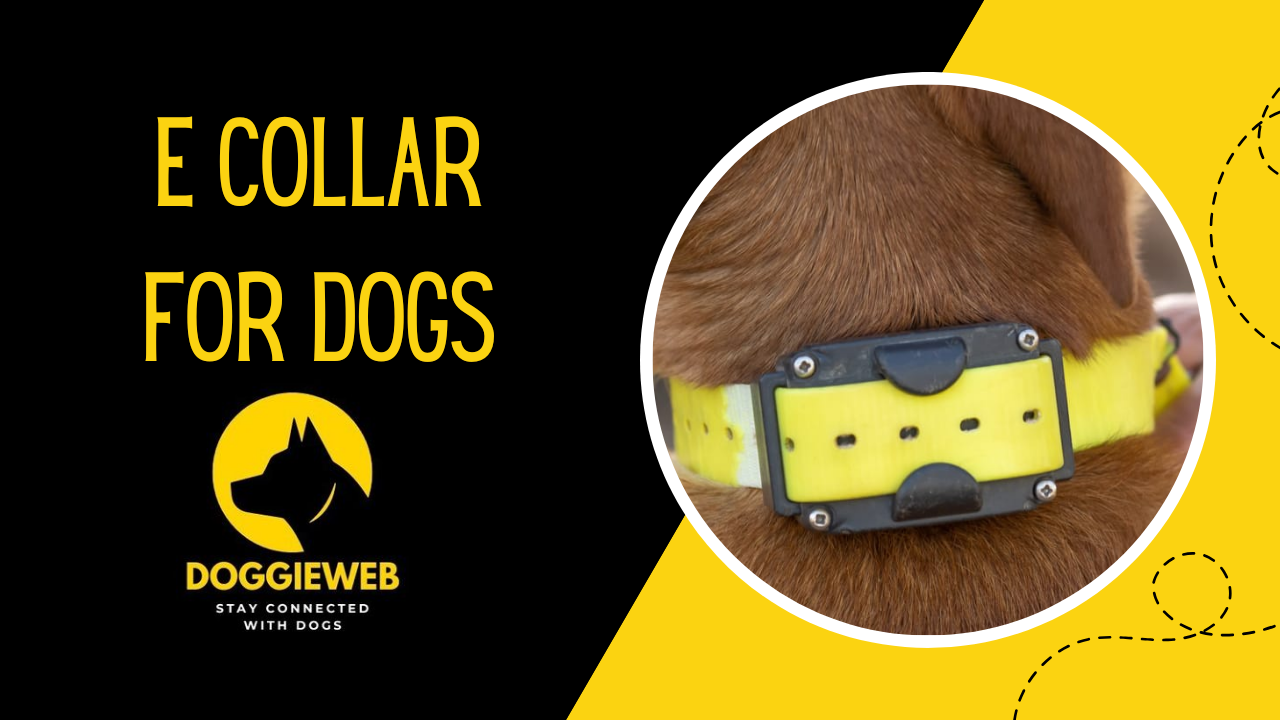Introduction
E Collar For Dogs, or distance learning collars, have become increasingly popular with dog and running shoe owners over the past few years. Designed as a useful resource in education, behaviour correction, and security, these devices have generated various opinions and debates. While some see them as essential equipment for responsible dog training, others are more specific about their ethical implications and potential for abuse. This article aims to provide an in-depth and balanced survey of E Collar For Dogs, delving into their records, types, blessings, potential risks, and considerations for responsible use.
History and development of electronic collars
The idea of electronic collars dates back to the mid-twentieth century when they were originally developed for looking at dogs. Early models were rudimentary, delivering a single degree of electrical shock to deter unwanted behaviour. These early devices were often harsh, leading to huge opposition from animal welfare agencies and dog owners. However, over time, improvements in generation and greater awareness of animal behaviour led to the development of more sophisticated electronic collars. Modern versions offer different stimulation ranges, including vibrations and tones. They are designed to be part of a complete training program rather than a stand-alone solution.
Types of electronic collars
Many forms of E Collar For Dogs are available today, each designed for dogs’ specific training needs and behaviour. The most unusual species include:
- Static Stimulation Collars: These collars give the dog a slight electrical impulse that can be adjusted in depth. They are often used to teach obedience and correct behaviours such as excessive barking or aggression.
- Vibrating Collars: These collars emit vibrations rather than a static discharge. They are usually used for puppies sensitive to electrical stimulation or people with hearing impairments, as the vibrations can still effectively get the dog’s attention.
- Tone collars: Tone collars emit an audible sound in preference to a physical stimulus. This form of collar is often used with other training methods and is mainly useful for memory training.
GPS and remote training collars combine GPS tracking with remote management capabilities, allowing owners to detect their dog’s area and provide necessary corrections. They are popular among hunters and those who have large houses.

How electronic collars work
Understanding how E Collar For Dogs work is essential to their effective and humane use. At their core, eAt electronic collars deliver a stimulus that the dog can understand as a legitimate, vibrating or static pulse. Controls this stimulus. The owner or trainer controls this stimulus via a remote control that allows them to deliver a correction from a distance. The purpose of the stimulus is to disrupt the dog’s modern behaviour and provide the owner with an opportunity to redirect the dog’s interest and give an impetus to the preferred behaviour.
Modern electronic collars are designed with safety features to prevent accidental overstimulation. For example, many models have built-in protection mechanisms that limit the length or depth of the stimulus, and some also include a warning tone or vibration that precedes the static correction, creating the danger that the dog has complied before experiencing a larger overstimulation.
Advantages of using electronic collars
When used responsibly, E Collar For Dogs can offer several blessings to dogs and their owners. One of the number one blessings is the ability to talk to a dog over long distances, which makes them especially useful for schooling in large open areas or puppy runs. E Collar For Dogs can also be effective in dealing with specific behavior problems that may be difficult to handle with other training techniques, such as excessive barking, chasing, or aggression.
In addition, electronic collars can increase the dog’s safety in positive situations. For example, a dog that has learned to respond reliably to the stimuli of an electronic collar may be less likely to get into risky situations, such as visits or encounters with wild animals. The potential for accurate unwanted behaviour from a distance can also save your dog from developing terrible behaviour when the owner is not always around.
Ethical considerations and potential risks
Despite the blessings, the use of E Collar For Dogs is not without controversy. Critics say electronic collars can cause physical and psychological harm to puppies, especially if used incorrectly. There is a problem that the use of electrical stimulation, even at low levels, can cause fear, anxiety or aggression in some puppies. In addition, there may be a risk that owners may also abuse the collar, either by using it too often, using it at an inappropriate depth, or relying on it for proper training and socialization.
Ethical dog training practices emphasize effective reinforcement that rewards desirable behaviours before punishing undesirable ones. From this angle, E Collar For Dogs are a last resort rather than a primary education tool. Proponents of E Collar For Dogs, however, say that when used effectively, the devices can be an effective part of a broader training method that involves positive reinforcement.
The importance of proper training and use
The key to proper and humane use of electronic collars lies in proper education and information. Dog owners and trainers must educate themselves on the ideal use of these aids, such as choosing the right collar for the dog’s size, temperament, and schooling preferences. Professional guidance from a qualified dog trainer is often recommended, especially for those new to e-collar training.
E-collar training should always start at the lowest possible intensity and gradually increase if necessary. The purpose is to discover the minimum level of stimulation the dog can understand without causing distress or pain. In addition, it is very important to pair the e-collar with nice reinforcement, such as treats or praise, to ensure that the dog associates the correction with the favourite behaviour instead of averting the stimulus.
Common misconceptions about electronic collars
Many misconceptions about electronic collars contribute to the ongoing debate about their use. One common perception is that E Collar For Dogs are inherently merciless or painful. While the early e-collar fashion was decidedly harsh, current versions are designed to provide a gentle, adjustable stimulus that’s more like a miracle than a punishment. Another false impression is that E Collar For Dogs are a short-term fix for behavioural problems. Effective e-collar training takes time, persistence, and a radical knowledge of dog behaviour.
It is also important to note that E Collar For Dogs are unsuitable for every dog or every situation. Dogs with a certain condition, younger puppies, or puppies with a history of fear-based aggression will not respond well to e-collar training. In such cases, alternative training strategies should be explored.
Alternatives to electronic collars
There are several alternative training techniques for dog owners who are uncomfortable with the idea of using an electronic collar. Positive reinforcement training, which involves rewarding the dog for favourite behaviours, is widely considered the most humane and effective method of dog training. Other alternatives include clicker training, where a small device makes a clicking sound that the dog associates with praise, and leash-primary training, which relies on physical guidance in preference to digital cues.
Behaviour modification apps, often developed in consultation with a professional dog trainer or animal behaviourist, can also effectively address specific issues, including resin, anxiety, or excessive barking. These programs usually combine educational techniques, environmental control, and, in a few cases, medicine.
Legal and regulatory aspects
Electronic collars are otherwise regulated depending on the U.S., a state, or a plU.S. In several places, electronic collars are completely banned, while in others, their use is limited to precise conditions or requires a professional license. For example, in the U.K., E Collar For Dogs are banned in Wales and strictly regulated in Scotland. In America, policies vary by state, with several states enforcing regulations on the sale and use of E Collar For Dogs.

Dog owners should familiarize themselves with the laws and policies of their region before purchasing or using an electronic collar. In addition, they must be aware of the possibility of prison legal liability if the electronic collar is misused or harms the dog or other persons.
Choosing the right E-collar for your dog
Choosing the right e-collar means considering several elements, such as the dog’s height, breed, temperament, and specific training requirements. Not all E Collar For Dogs are created equal, and choosing the wrong collar can result in ineffective training or possibly injury to the dog.
When choosing an e-collar, look for models that provide adjustable levels of stimulation, various modes (consisting of tone, vibration and static), and safety features such as a computerized shutdown or lock to save you from accidental activations. The collar should fit tightly but simply around the dog’s neck, with the contact points touching the pores and skin properly without causing inflammation.
In addition, it is important to keep in mind the versatility of the remote control, especially if you plan to use the e-collar for teaching in large outdoor areas. Battery lifestyle, durability, and water resistance are various critical factors that you should not overlook, especially if the collar will be used in many weather conditions or for activities such as swimming.
Training tips for e-collar success
Effective e-collar teaching requires proper conceptual planning and consistency. Start by introducing the collar to your dog in a neutral and efficient environment and letting him get used to wearing it without stimulation. Start schooling sessions with low-pressure exercises; using a lower level of stimulation is important to get the dog interested.
It’s important to pair e-collar stimulation with clear instructions and high-quality reinforcement. For example, if you use the collar to reinforce memory, give the remember command. If the dog does not respond, use the electronic collar on the lowest setting, accompanied by a reward or treat when the dog complies. This lets the dog understand that responding to the command turns off the stimulation and gets the reward.
Training periods should be kept short and focused, increasing in complexity step by step as the dog becomes extra skilled and sensitive. Patience and consistency are key, as rushing the technique can cause confusion or stress for the dog. Remember, using an e-collar is to embellish the verbal exchange with your canine, not to punish them. If you are aware of any signs and symptoms of distress, which include cowering, screaming or refusing to go to school, it is essential to stop and reassess your technique. Reducing the stimulation level or switching to a different educational approach may be vital.
Additionally, getting a professional dog trainer involved is helpful, especially if you are new to e-collar training. A qualified instructor will help you understand how to use the collar successfully, tailor training to your dog’s unique needs, and ensure the process is humane and constructive.
Monitoring and adjusting the training process
As with other training tools, ongoing monitoring and adjustments are essential when using an e-collar. Dogs are people, and what works for one may not work for another. Regularly evaluate your dog’s development and be willing to change your training plan if necessary. This should include adjusting the stimulation level, changing the school environment, or incorporating other educational techniques.

The future of electronic collars: Innovations and trends
The theme of the dog school era is constantly evolving, and electronic collars are no exception. Recently, there has been a fashion for more sophisticated and humane electronic collar designs that focus on minimizing pain and improving verbal exchange between puppies and their owners. For example, some newer mods include advanced features such as adaptive stimulation that mechanically adjusts intensity based entirely on the dog’s response or real-time note systems that allow owners to track their dog’s behaviour and stress levels.
There is also growing interest in integrating E Collar For Dogs with various technologies, such as phone apps and wearables, to create more comprehensive and customizable training solutions. These improvements will likely continue as more research is conducted into dog behaviour and training strategies, leading to better equipment and strategies for responsible dog owners.
Conclusion
E Collar For Dogs for puppies are effective equipment that can improve training and protection when used correctly and responsibly. However, they are not a one-size-fits-all solution and should be approached with care, caution, and deep information for both the dog and the generation. By choosing the right e-collar, following good training practices and paying maximum attention to how your dog looks good, you can use the e-collar as a rare piece of a wider training strategy.
Dog owners need to educate themselves thoroughly and seek professional guidance, and it is vital to ensure that e-coE Collar For Dogs are humane. With the right method, E Collar For Dogs can be a beneficial device that contributes to a happy, well-behaved and safe dog and ultimately strengthens the bond between dog and owner. As with all aspects of dog care and training, the focus should always be on what satisfies the dog, ensuring that their physical and emotional desires are met with kindness and appreciation.










